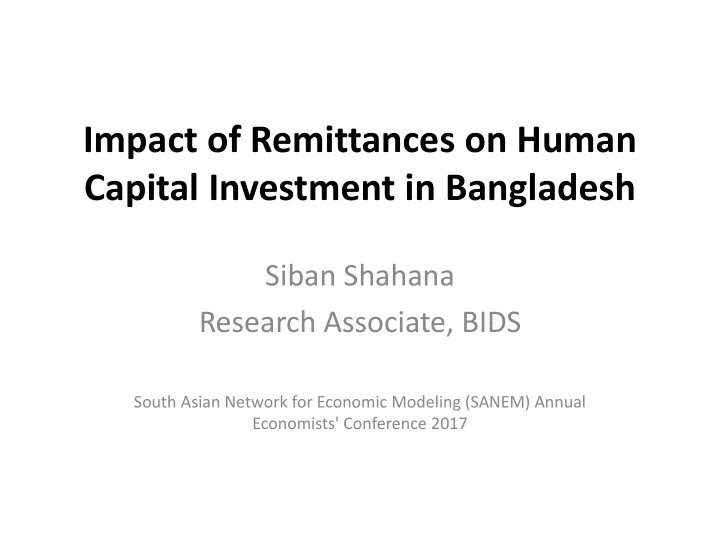

Impact of Remittances on Human Capital Investment in Bangladesh Siban Shahana Research Associate, BIDS South Asian Network for Economic Modeling (SANEM) Annual Economists' Conference 2017
Overview • If remittances primarily enhance consumption, they may have no lasting impact on economic growth. • Only through asset accumulation and human capital investment, remittances may serve as a vehicle for growth. • Hence, it is very important to ensure the proper utilization of remittance.
Research Question • The most effective type of investment that a migrant can make is promoting the education of his or her children • However, investing in education is a choice that households may or may not make. • Much of the investment in child education doesn’t have immediate benefit and the returns are in the future. Investigate the impact of remittance on child education for households with migrants in Bangladesh.
Literature Review • The question of how households spend or use remittances is a topic of lively debate • Chami et al. (2003) - “ significant proportion, and often the majority” of remittances is spent on “status - oriented” consumption goods • Survey of Investment from Remittance (SIR)-2016 (75% consumption and 25% investment) • Adams and Cuecuecha (2010) -households receiving international remittances spend less at the margin on food — and more at the margin on two investment goods — education and housing
Literature Review (cont.) • Raihan et.al (2009) show that the impacts of remittances on education and health expenditures are positive but insignificant implying a limited role of remittances in fostering development of human capital • Dorantes and Pozo (2010) illustrates that while girls’ school attendance rises with the receipt of remittances while also noting that migration of family members may temper and even cancel-out the positive remittance effect
Data • Household Income and Expenditure Survey (HIES), 2010 • Information regarding migration of any member of the households was collected along with information about their age, sex, education, occupation, name of district, country of migration, duration of stay, amount of remittances sent during last 12 months etc • Education status and expenditure of the children
Methodology • There are at least four methodological challenges that confront any economic (or social science) work on international migration and remittances. simultaneity reverse causality selection bias and omitted variables • In four specification I try to estimate the impact- 2 OLS Instrumental Variables (IV) approach with Two-Stage Least Squares (2SLS) (interaction between GDP fluctuation in the destination country & remitter dummy and district level remitter intensity used as IV) PSM
SECTION 2: EDUCATION PART B: CURRENT ENROLLMENT (ALL PERSONS 5 YEARS AND OLDER) ID CODE as in Roster EXPENDITURE DURING THE PAST 12 MONTHS FOR EDUCATION 8 How much did your household spend during the past 12 months on your schooling? WRITE THE EXPENSES IN TAKA IF NOTHING WAS SPENT, WRITE "0" (ZERO) IF UNKNOWN, LEAVE BLANK A B C D E F G H I J K L M N O P Cost of Text Exercise Uniform Hostel Other, Admission Annual/ Registration Examination Tuition Private Transport Tiffin Donation Total Internet and books, books, dress, Expenses specify e-mail fees session fees fees fees fees note book stationary footwear tutoring (incl food) cost cost (edu. related) (edu. related)
Descriptive Statistics Boy Children Girl Children Level of Edu. Exp. HH Type Freq. % Education (BDT) Freq. Percent Freq. Percent No Pre- 321 4.52 259 3.7 14,541 International 11,106 90.74 primary Remitter Primary 3,688 51.97 3,807 54.46 10,805 International 1,134 9.26 Secondary 2,822 39.76 2,830 40.48 29,247 Remitter Tertiary 266 3.75 95 1.36 32,780 Total 12,240 100 Total 7,097 100 6,991 100 ---
Results • Controlled for various socio-economic covariates (HH head’s gender, education level, mother’s education, income, asset, location, HH size, number of school going children etc.) • District level fixed effect considered • Clustered standard error • Valid IV(F>10) • No over identification
Result(PSM) • Outcome variable(log of Education expenditure) • PSM result similar to OLS • Difference significant
Limitations • Potential offsetting effects of migration and remittances not captured • Only education expenditure is considered not the performance of the students • Others
Thank You Questions and suggestions?
Recommend
More recommend